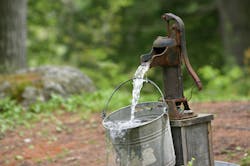Managed aquifer recharge tool expected to grow as drought continues
WESTERVILLE, Ohio — Dec. 29, 2015 — The National Ground Water Association (NGWA) expects managed aquifer recharge (MAR) to become an increasingly important tool as municipalities continue to deal with struggling water supplies in 2016, according to a press release.
Under controlled conditions, MAR replenishes aquifers by capturing water that is available during low-demand or wet periods, "or water that would be lost otherwise," noted the release.
"MAR will become an increasingly important tool for mitigating the economic, environmental and public health impacts of water shortages," said William Alley, Ph.D., NGWA’s director of science and technology, in the release. Alley also noted that MAR requires "proper siting selection, design, construction, operation and maintenance, but it can be done."
In addition to contributing to stable water supplies during drought, MAR projects can also mitigate land subsidence, supplement the quantity of groundwater and improve its quality, manage runoff and floodwaters and reduce or halt saltwater intrusion, reported the release.
Hundreds of MAR project have been implemented across the U.S., stated the release. "Successful MAR projects include ones operated by the Orange County (California) Water District; Central Arizona Groundwater Replenishment District; the Peace River Manasota Regional Water Supply Authority (Florida); United Water Resources (Idaho); Rio Rancho, New Mexico; and Dayton, Ohio."
Groundwater supplies about 78 percent of community systems and individual households with independent water sources with water, shared the release. Forty-two percent of the country’s agricultural irrigation water also comes from groundwater.
Groundwater is also instrumental in supporting environmental benefits and ecosystems as it feeds streams and rivers, noted the release.
You can find the entire release here.
